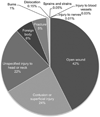Epidemiological survey of head and neck injuries and trauma in the United States
- PMID: 25139950
- PMCID: PMC4481864
- DOI: 10.1177/0194599814546112
Epidemiological survey of head and neck injuries and trauma in the United States
Abstract
Objective: Head and neck trauma results in a range of injuries, spanning minor lacerations to life-threatening airway compromise. Few studies provide in-depth analysis of injuries to the head and neck (HN). We aim to (1) describe HN injury prevalence in the US and (2) investigate patient disposition and the outcome of mortality.
Study design: Case series with chart review.
Setting: Nationwide emergency department (ED) sample.
Methods: The 2011 database was queried for encounters with a primary diagnosis of HN injury, as categorized by the Barell Injury Matrix. Weighted estimates for demographics, injury category, and mechanism were extracted. Predictors of mortality and admission were determined by multivariable regression.
Results: We identified 131 million ED encounters. A weighted total of 5,418,539 visits were related to primary HN injuries. Average age was 30 (SE = 0.4), and 56.8% were male. Sixty-four percent of injuries were attributed to fall or blunt trauma. Open wounds comprised 41.8% of injuries. The most common procedure was laceration repair (70%). The majority of patients (97%) were discharged home. Mortality rate was less than 1%. Predictors of admission and mortality (P < .05) included multiple trauma, vessel trauma, and burns. Other risk factors included foreign-body, older age, and male gender.
Conclusions: Primary HN injuries commonly present to emergency rooms in the US. The majority of HN injuries are non-life threatening and do not require admission to the hospital or result in death. These data have implications for HN injury surveillance and may be used to risk-stratify patients who present with injuries in the acute care setting.
Keywords: emergency department; head and neck; injury; otolaryngology; trauma.
© American Academy of Otolaryngology-Head and Neck Surgery Foundation 2014.
Conflict of interest statement
R.K.V.S., E.D.K., D.J.L., M.G.S., S.T.G. have no conflicts of interest to report.
Figures





References
-
- Mackenzie EJ, Rivara FP, Jurkovich GJ, et al. The National Study on Costs and Outcomes of Trauma. J Trauma. 2007 Dec;63(6 Suppl):S54–S67. discussion S81–6. - PubMed
-
- Sastry SM, Sastry CM, Paul BK, Bain L, Champion HR. Leading causes of facial trauma in the major trauma outcome study. Plast Reconstr Surg. 1995 Jan;95(1):196–197. - PubMed
-
- Wade AL, Dye JL, Mohrle CR, Galarneau MR. Head, face, and neck injuries during Operation Iraqi Freedom II: results from the US Navy-Marine Corps Combat Trauma Registry. J Trauma. 2007 Oct;63(4):836–840. - PubMed
-
- Allareddy V, Allareddy V, Nalliah R. Epidemiology of Facial Fractures. Journal of Oral and Maxillofacial Surgery. 2011;69(10):2613–2618. - PubMed
MeSH terms
Grants and funding
LinkOut - more resources
Full Text Sources
Other Literature Sources
Medical

